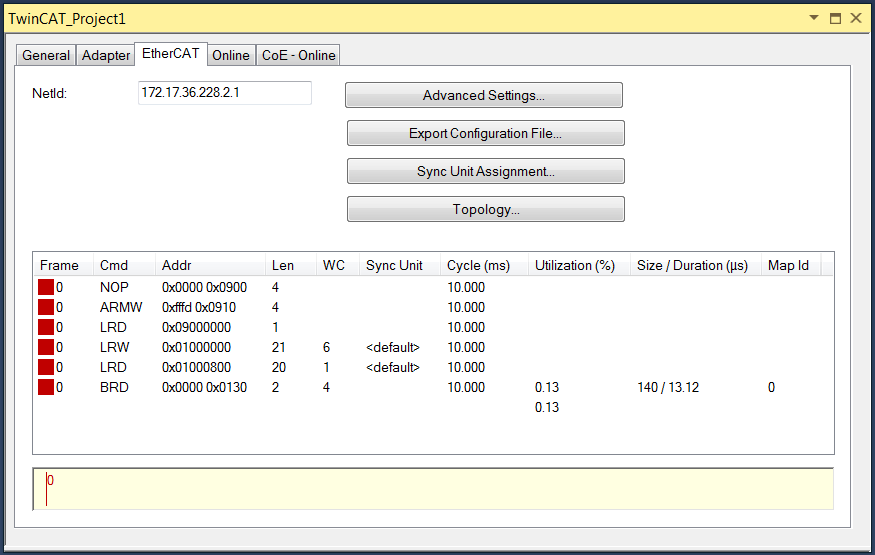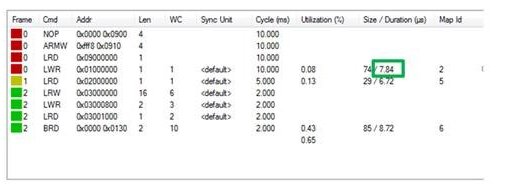EtherCAT
EtherCAT, "EtherCAT" tab
The "EtherCAT" tab becomes available when you select the EtherCAT master device in the IO tree.

"NetId" text box
The "NetId" text box contains the NetId of the EtherCAT master device. The NetId parameter is required for communication with the EtherCAT master device via ADS. The ADS port of the EtherCAT master is always 0xFFFF (65535). The ADS port of an EtherCAT slave device matches the fixed address (see EtherCAT Addr) of the slave device.
"Advanced Settings…" button
The "Advanced Settings…" button opens the "Advanced Settings" dialog. This dialog contains additional setting options for the EtherCAT master device, among others.
"Export Configuration File…" button
The "Export Configuration File…" button opens a "Save as" dialog for saving the XML master configuration file. This file describes the process data and the transfer frames that are sent during the EtherCAT state transitions. This function is intended particularly for third-party masters.
"Sync Unit Assignment…" button
The "Sync Unit Assignment…" button opens the "Sync Unit Assignment" dialog. This dialog can be used to group EtherCAT slave devices into different Sync Units. Based on this Sync Unit grouping, datagrams are generated that open up enhanced diagnostic options.
Each datagram ends with a Working Counter. Sync Units have their own Working Counters, because they send their data in their own datagrams. If the Working Counter indicates that a datagram has an error, the faulty datagram is no longer updated. It is therefore possible to define Sync Units for separate operating units.
"Topology…" button
The "Topology…" button opens the topology dialog. This dialog displays the topology of the configured EtherCAT slave devices and also contains online data of the configured EtherCAT slave devices.
"Frame" column
The "Frame" column shows the number of the cyclic transfer frame, which contains the respective EtherCAT command. An EtherCAT transfer frame can contain one or more EtherCAT commands.
"Cmd" column, EtherCAT commands
The list view at the bottom of the "EtherCAT" dialog shows all cyclic EtherCAT commands sent by the EtherCAT master. The "Cmd" column shows the type of the respective EtherCAT command.
"Addr" column
The "Addr" column shows the address of the data section of the EtherCAT slave device that addresses the respective command. If the respective EtherCAT command uses logical addressing (LRW, LW or LR), then the "Addr" column specifies the logical address.
"Len" column
The "Len" column shows the length of the addressed data section.
"WC" column
The "WC" column shows the expected "working counter". Each EtherCAT slave device addressed by an EtherCAT command increments the "working counter".
Command | Success | WC increment |
|---|---|---|
Read command | No success | No change |
Reading successful | +1 | |
Write command | No success | No change |
Writing successful | +1 | |
Read/write command | No success | No change |
Reading successful | +1 | |
Writing successful | +2 | |
Reading and writing successful | +3 |
If, for example, a logical read-write command (LRW) is encountered, each EtherCAT slave device to which data is written increments the working counter by 2, each EtherCAT slave device from which data is read increments the working counter by 1.
"Sync Unit" column
The "Sync Unit" column shows the name of the Sync Unit associated with the EtherCAT command.
"Cycle (ms)" column
The "Cycle (ms)" column shows the cycle time with which the transfer frame is sent.
"Utilization (%)" column
The "Utilization (%)" column shows the EtherCAT load in percent.
"Size / Duration (µs)" column
"Size" indicates the size of an EtherCAT frame in bytes. "Duration" indicates the time in microseconds that a frame needs to be transmitted by the master through the network card (the propagation time of the frame through the network is not included).
Example for calculation size and duration for frame 0 with 4 datagrams :

Part of EtherCAT frame | Size in byte |
|---|---|
Ethernet Header | 14 |
EtherCAT Header | 2 |
Datagram Header (10 byte/Datagram) | 4 * 10 = 40 |
Datagram Data (Len) | 4 + 4 + 1 + 1+ = 10 |
Datagram WKC (2 byte/Datagram) | 4 * 2 = 8 |
=> Size | 74 |
Ethernet FCS | 4 |
Ethernet Interpacket gap (12 byte) + Preamble (7 byte) + SOF (1 byte) | 20 |
=> Total frame size | 98 (784 bit) |
Duration: 784 bit / 100 Mb/s = 7,84 µs | |